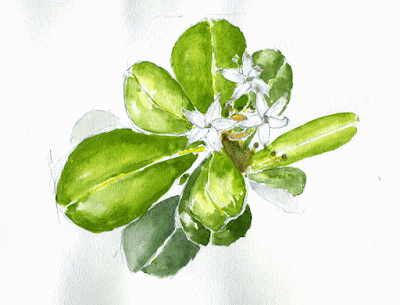Where has May gone? I feel the time running through my hands like water. ( I stole that image from my sister-in-law, E.).
Apart from a few afternoons, it hasn't been terribly hot yet; in that regard it clearly is not summer.
South Florida does have seasonal patterns. Things start happening by late February or early March, and the pace gets increasingly hectic until the onset of drowning rains and crushing heat of deep summer applies some brakes.
Every plant and animal seems intent on reproducing. For plants that means germination, growing, flowering, seed production all at a dizzying rate. I can't draw fast enough to record the abundance, much less the process.
Despite drought*, abundant sunshine and seemingly incessant wind, the yard is full of furiously blooming plants, crowding each other, sprawling over each other, all vying for the most light. White and lavender Heliotropium groundccovers, Gaillardias, Coreopsis, Dune Sunflower, Camphor Weed (Pluchea rosea), Goldenrod, Blue Porterweed, Gopher Apple (Licania michauxii), Vinca, Scarlet Sage (Salvia coccinea), and Bidens alba are all vying for attention up to a few feet off the ground. Frangipani, Jamaica Caper, 7-Year Apple (Genipa clusiifolia), Red Geiger, Bougainvillia, and Simpson's Stopper round out the list for flowering trees and shrubs.
 |
Intensely Fragrant Genipa clusiifolia |
The first tiny Easstern Lubber grasshopper nymphs, which popped out of the ground in early February, have turned into adults. Birds are nesting. Osprey "chicks" have mostly fledged by now. Tropical hardwoods like gumbo limbo and mahogany are shedding their leaves in anticipation of summer's rains.
 |
| Lubber Grasshopper Nymphs. These individuals have molted several times already. |
 |
| Adult Lubber. It was crawling up a screen. Don't know why I didn't sketch that. |
Monarch caterpillars are devouring milkweed faster than I can coax it to grow. Even if you can find plants in garden centers, by now they usually already have caterpillars or eggs on them. I feel like a factory worker in the old Soviet Union. As soon as he met his quota for the month, the reward was a higher quota to meet. And on and on. It's the same with the caterpillars - raise one or two successfully, and before you know it you've got multiple broods chomping down leaves and even stems. If I can't find some more milkweed, some of my caterpillars are going to starve.
I would like to use native milkweeds instead of the West Indian scarlet milkweed (Asclepius curassavica), but they just aren't available. Even my trusty native plant nurseryman hasn't had success bringing them through our hot and humid summers.
 |
| Asclepias perennis. I can't bring it through our summers. |
Perhaps we butterfly gardeners are pushing the monarchs' range farther south than it should be, and encouraging them to stick around instead of migrating, but we are in the range of their cousins the queens and soldiers. The fact that both have been around for a while makes me think that there must be some native milkweed(s) surviving further inland. White twinevine (Sarcostemma clausum) is one possibility - I've seen it growing in several locales, but it wouldn't provide a great deal of forage, so there must be others. For some reason the queen population in my yard has crashed. I used to have swarms. Last year I had just a few, and I haven't seen any at all so far in 2018.
The downside of all the vegetative abundance in the yard is that there are far too many plants for it to be a garden. At present large parts of this small plot are virtually impassible for anything other than rodents, reptiles and birds. I hate to rip out perfectly healthy plants, but from time to time I have to harden my heart. It would be nice to have a garden again.
 |
A Riot of Color; Not So Good for Moving Around |
No comments:
Post a Comment